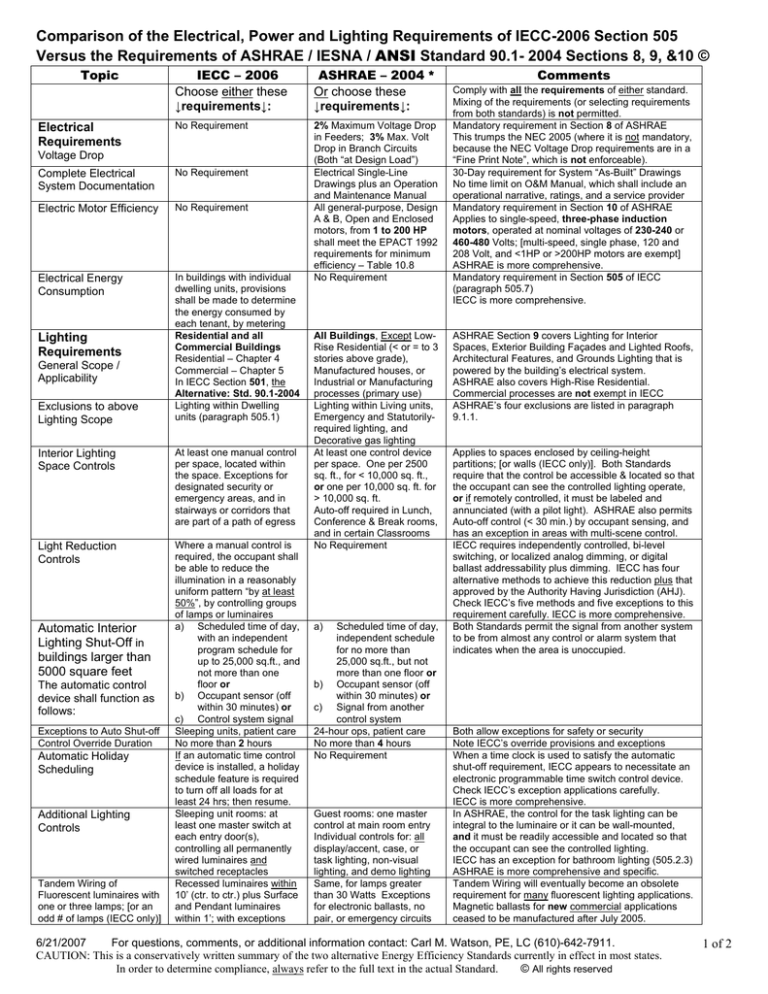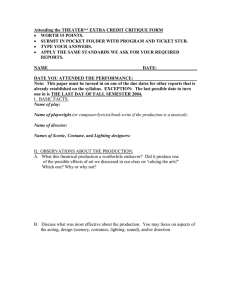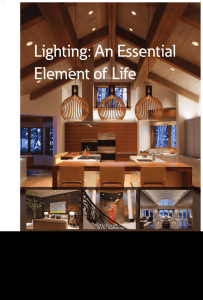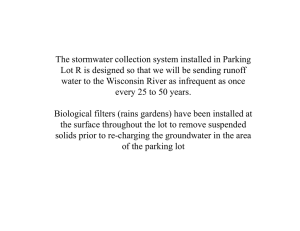
Comparison of the Electrical, Power and Lighting Requirements of IECC-2006 Section 505
Versus the Requirements of ASHRAE / IESNA / ANSI Standard 90.1- 2004 Sections 8, 9, &10 ©
Topic
Electrical
Requirements
IECC – 2006
Choose either these
↓requirements↓:
ASHRAE – 2004 *
Or choose these
↓requirements↓:
No Requirement
2% Maximum Voltage Drop
in Feeders; 3% Max. Volt
Drop in Branch Circuits
(Both “at Design Load”)
Electrical Single-Line
Drawings plus an Operation
and Maintenance Manual
All general-purpose, Design
A & B, Open and Enclosed
motors, from 1 to 200 HP
shall meet the EPACT 1992
requirements for minimum
efficiency – Table 10.8
No Requirement
Voltage Drop
Complete Electrical
System Documentation
No Requirement
Electric Motor Efficiency
No Requirement
Electrical Energy
Consumption
In buildings with individual
dwelling units, provisions
shall be made to determine
the energy consumed by
each tenant, by metering
Residential and all
Commercial Buildings
Residential – Chapter 4
Commercial – Chapter 5
In IECC Section 501, the
Alternative: Std. 90.1-2004
Lighting within Dwelling
units (paragraph 505.1)
Lighting
Requirements
General Scope /
Applicability
Exclusions to above
Lighting Scope
Interior Lighting
Space Controls
At least one manual control
per space, located within
the space. Exceptions for
designated security or
emergency areas, and in
stairways or corridors that
are part of a path of egress
Light Reduction
Controls
Where a manual control is
required, the occupant shall
be able to reduce the
illumination in a reasonably
uniform pattern “by at least
50%”, by controlling groups
of lamps or luminaires
a) Scheduled time of day,
with an independent
program schedule for
up to 25,000 sq.ft., and
not more than one
floor or
b) Occupant sensor (off
within 30 minutes) or
c) Control system signal
Sleeping units, patient care
No more than 2 hours
If an automatic time control
device is installed, a holiday
schedule feature is required
to turn off all loads for at
least 24 hrs; then resume.
Sleeping unit rooms: at
least one master switch at
each entry door(s),
controlling all permanently
wired luminaires and
switched receptacles
Recessed luminaires within
10’ (ctr. to ctr.) plus Surface
and Pendant luminaires
within 1’; with exceptions
Automatic Interior
Lighting Shut-Off in
buildings larger than
5000 square feet
The automatic control
device shall function as
follows:
Exceptions to Auto Shut-off
Control Override Duration
Automatic Holiday
Scheduling
Additional Lighting
Controls
Tandem Wiring of
Fluorescent luminaires with
one or three lamps; [or an
odd # of lamps (IECC only)]
All Buildings, Except LowRise Residential (< or = to 3
stories above grade),
Manufactured houses, or
Industrial or Manufacturing
processes (primary use)
Lighting within Living units,
Emergency and Statutorilyrequired lighting, and
Decorative gas lighting
At least one control device
per space. One per 2500
sq. ft., for < 10,000 sq. ft.,
or one per 10,000 sq. ft. for
> 10,000 sq. ft.
Auto-off required in Lunch,
Conference & Break rooms,
and in certain Classrooms
No Requirement
a)
Scheduled time of day,
independent schedule
for no more than
25,000 sq.ft., but not
more than one floor or
b) Occupant sensor (off
within 30 minutes) or
c) Signal from another
control system
24-hour ops, patient care
No more than 4 hours
No Requirement
Guest rooms: one master
control at main room entry
Individual controls for: all
display/accent, case, or
task lighting, non-visual
lighting, and demo lighting
Same, for lamps greater
than 30 Watts Exceptions
for electronic ballasts, no
pair, or emergency circuits
Comments
Comply with all the requirements of either standard.
Mixing of the requirements (or selecting requirements
from both standards) is not permitted.
Mandatory requirement in Section 8 of ASHRAE
This trumps the NEC 2005 (where it is not mandatory,
because the NEC Voltage Drop requirements are in a
“Fine Print Note”, which is not enforceable).
30-Day requirement for System “As-Built” Drawings
No time limit on O&M Manual, which shall include an
operational narrative, ratings, and a service provider
Mandatory requirement in Section 10 of ASHRAE
Applies to single-speed, three-phase induction
motors, operated at nominal voltages of 230-240 or
460-480 Volts; [multi-speed, single phase, 120 and
208 Volt, and <1HP or >200HP motors are exempt]
ASHRAE is more comprehensive.
Mandatory requirement in Section 505 of IECC
(paragraph 505.7)
IECC is more comprehensive.
ASHRAE Section 9 covers Lighting for Interior
Spaces, Exterior Building Façades and Lighted Roofs,
Architectural Features, and Grounds Lighting that is
powered by the building’s electrical system.
ASHRAE also covers High-Rise Residential.
Commercial processes are not exempt in IECC
ASHRAE’s four exclusions are listed in paragraph
9.1.1.
Applies to spaces enclosed by ceiling-height
partitions; [or walls (IECC only)]. Both Standards
require that the control be accessible & located so that
the occupant can see the controlled lighting operate,
or if remotely controlled, it must be labeled and
annunciated (with a pilot light). ASHRAE also permits
Auto-off control (< 30 min.) by occupant sensing, and
has an exception in areas with multi-scene control.
IECC requires independently controlled, bi-level
switching, or localized analog dimming, or digital
ballast addressability plus dimming. IECC has four
alternative methods to achieve this reduction plus that
approved by the Authority Having Jurisdiction (AHJ).
Check IECC’s five methods and five exceptions to this
requirement carefully. IECC is more comprehensive.
Both Standards permit the signal from another system
to be from almost any control or alarm system that
indicates when the area is unoccupied.
Both allow exceptions for safety or security
Note IECC’s override provisions and exceptions
When a time clock is used to satisfy the automatic
shut-off requirement, IECC appears to necessitate an
electronic programmable time switch control device.
Check IECC’s exception applications carefully.
IECC is more comprehensive.
In ASHRAE, the control for the task lighting can be
integral to the luminaire or it can be wall-mounted,
and it must be readily accessible and located so that
the occupant can see the controlled lighting.
IECC has an exception for bathroom lighting (505.2.3)
ASHRAE is more comprehensive and specific.
Tandem Wiring will eventually become an obsolete
requirement for many fluorescent lighting applications.
Magnetic ballasts for new commercial applications
ceased to be manufactured after July 2005.
6/21/2007
For questions, comments, or additional information contact: Carl M. Watson, PE, LC (610)-642-7911.
CAUTION: This is a conservatively written summary of the two alternative Energy Efficiency Standards currently in effect in most states.
© All rights reserved
In order to determine compliance, always refer to the full text in the actual Standard.
1 of 2
Topic
Exterior
Lighting
Controls
Exterior
Building
Grounds
Lighting
Efficacy
Power
Density
Limits for
Building
Exterior
Lighting
Exit Signs
Luminaire
Wattage
Interior
Lighting
Power (ILP)
ILPD –
Interior
Lighting
Power Density
Limits
ILPD –
Interior
Lighting
Power Density
Limits
Existing
Bldg. Lighting
System
Alterations
Exceptions to
Lighting
System
Alterations
IECC – 2006
ASHRAE – 2004 *
Comments
Photo sensor or Astronomical
Time Switch; Clock shall have at
least a 10-hour Power back-up
(Outage ride-through) capability.
Same exceptions as ASHRAE
Photo sensor or Astronomical Time
Switch with 10-hour min. back-up
Exceptions for covered vehicle
entrances or exits from buildings or
parking structures where required for
safety, security, or eye adaptation
When supplied through the
All exterior building grounds
building, all luminaires [lamp and luminaires [powered by the building]
ballast] that operate at greater
that operate at greater than 100
than 100 Watts shall contain
Watts shall contain lamps with a
lamps with a minimum efficacy of
minimum efficacy of 60 Lumens /
60 Lumens / Watt, unless
Watt, unless controlled by a motion
controlled by a motion sensor,
sensor, with four exclusions (9.1.1)
with nine exceptions in 505.6.2.
plus same nine exceptions in 9.4.5.
Uncovered Parking Areas: 0.15 Watts / Square foot (Tradable)
Walkways <10’ wide: 1.0 Watts/ Linear foot (Tradable)
Walkways >10’ wide: 0.2 Watts / Square foot (Tradable)
Stairways: - 1.0 Watts / Square foot (Tradable)
Building Entrance (without Canopy): 30 Watts / Linear foot of Door width
Building Exit: 20 Watts / Linear foot of Door width (Tradable)
Building Entrance with a Canopy or a Free Standing Canopy: 1.25 Watts
/ Square foot of horizontal surface (Tradable)
Building Façade Lighting: 0.2 Watts / Sq. Ft. of lighted area, or 5.0 Watts
/ Linear foot of lighted surface length (Non-Tradable)
Drive-up windows at fast food restaurants: 400 Watts per drive-thru (NT)
Internally Illuminated signs shall
Internally Illuminated signs shall not
not exceed 5 Watts per side
exceed 5 Watts per face
a) Screw lamp holders – the
a) Medium screw base sockets w/o
maximum labeled wattage of
ballasts -- maximum labeled
the luminaire
wattage of the luminaire
b) Low-voltage lighting – the
b) Luminaires with permanently
specified wattage of
installed or remote ballasts or
transformer supplying the
transformers – maximum
system
wattage of lamp / ballast (lamp /
c) Line-voltage track and plugauxiliary) combination
in busway – the greater of
c) Low-voltage track, cable or rail
30 Watts / Linear foot of
lighting – wattage of transformer
track or the sum of wattages
d) Line-voltage track and plug-in
of the specified equipment
busway – greater of 30 Watts /
d) Other luminaires – per data
linear foot or the sum of the
specified wattages of luminaires
furnished by the
included in system
manufacturer or other
e) All other lighting – as specified
approved sources
Section 505.5.1 lists five specific
Section 9.2.2.3 lists fifteen different
exceptions to the total connected
exceptions to ILP. Each must not be
general lighting and each must have
interior lighting power (ILP) load.
an independent control device.
Table 505.5.2 -- Interior Lighting
Table 9.5.1 -- Lighting Power Density
Power Density – on an entire or
using the Building Area Method
whole building basis -- (page 50)
(page 64)
The ILPD Limits are listed as the
The ILPD Limit values are listed as
Maximum Watts per Square Foot
the Maximum Watts per Square Foot
permitted for a particular use.
permitted for a particular use.
Table 9.6.1 -- Lighting Power Density
Table 505.5.2 -- Interior Lighting
using the Space by Space Method
Power Density – (page 50)
(pages 65-66)
ASHRAE provides an additional table
NOTE: IECC allows the same
ILPD limits to be used for portions
with slightly higher ILPD limit values
for its space-by-space method, and it
of the building, but these values
has a much more comprehensive
are no greater than the ILPD
variety of application choices.
limits for the whole building
The ILPD Limits are listed as the
Maximum Watts per Square Foot
permitted for a particular use.
Additions, alterations,
renovations or repairs to a
lighting system, or portion thereof,
shall conform to all provisions of
IECC.
The unaltered portion(s) of the
existing lighting system is (are)
not required to comply with IECC.
Alterations involving > 50% of the
building area trigger compliance.
The ILPD Limit values are listed as
the Maximum Watts per Square Foot
permitted for a particular use.
Replacement of lighting systems in
any space, and all new lighting
systems, shall comply with the
applicable LPD requirements of
Section 9.
Alterations that replace < 50% of the
luminaires in a space; provided that
such alterations do not increase the
installed interior lighting power [new
lighting load must be < or = old load]
The exception for lighting controlled by a motion
sensor, allows use of “instant-on” lighting for
security applications, without the minimum
efficacy restriction. IECC has an exclusion for
low-voltage landscape lighting (505.6). IECC
also has an exception for approved historical,
signage, safety or emergency applications
(505.6).
The Exterior Building Lighting Power Allowance is
the sum of all the lighting applications present at
that building, plus an additional unrestricted 5%.
The Non-Tradable (NT) Surfaces are in addition
to allowances permitted in the Tradable Surfaces.
These are “Use it or Lose it” allowances; meaning
they can be claimed only if actually present, and
they cannot be combined (traded) with any other
exterior allowance. See IECC Table 505.6.2 or
ASHRAE Table 9.4.5, which have the identical
surface categories and limit values.
Essentially the same
Compare the actual text in each of the two
Standards
Note that IECC pertains only to the “conditioned
space” (floor area) portion of the building.
Both IECC and AHSRAE use the same table
categories and limit values for the whole building
(building area) prescriptive method.
ASHRAE offers a Space-by-Space method that
provides applicability flexibility due to its large
matrix of space types and uses. Both Standards
permit differently limited extra power density
allowances for retail display lighting. ASHRAE
has additional ILPD allowances for decorative
lighting and lighting for visual display terminals
(VDTs). ASHRAE’s VDT allowance is only
applicable to lighting systems that do not exceed
the luminance [brightness] limits listed in the
Standard (maximum average luminance values at
specific viewing angles).
Examine IECC Chapter 1, Section 101.4.3.
See International Existing Building Code (IEBC2006): Chapter 4, Alterations; where adopted.
ASHRAE also requires compliance with the
Space Control provisions of Section 9.4.1.2 (b).
Both ASHRAE and IECC have reduced
requirements, or exemptions, for authentic
historic buildings. Consult the local Authority
Having Jurisdiction (AHJ) for more information.
*ASHRAE Standard 90.1 is the only standard for compliance with LEED-NC® (Leadership in Energy and Environmental Design).
6/21/2007
For questions, comments, or additional information contact: Carl M. Watson, PE, LC (610)-642-7911.
CAUTION: This is a conservatively written summary of the two alternative Energy Efficiency Standards currently in effect in most states.
© All rights reserved
In order to determine compliance, always refer to the full text in the actual Standard.
2 of 2



